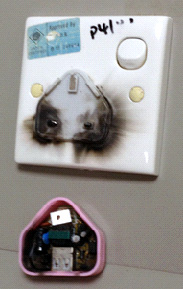While USB chargers are a convenient way to recharge our energy draining portable devices, poor quality and inexpensive look-alike chargers may pose a fire and electrical hazard.
 Recently, a student charging her phone in the Science Library noticed wisps of smoke emerging from her USB Charger. Fortunately, her immediate reaction was to turn off the mains switch. However, her subsequent attempt to unplug the charger resulted in the case giving way, revealing a blackened interior where parts of the electronic circuits had vaporized. The remaining half was still stuck in the socket, its exposed pins surrounded by streaks of soot. Her quick thinking had probably saved her phone and averted further danger, but how many of us are actually attentive to the state of the charger after plugging it in?
Recently, a student charging her phone in the Science Library noticed wisps of smoke emerging from her USB Charger. Fortunately, her immediate reaction was to turn off the mains switch. However, her subsequent attempt to unplug the charger resulted in the case giving way, revealing a blackened interior where parts of the electronic circuits had vaporized. The remaining half was still stuck in the socket, its exposed pins surrounded by streaks of soot. Her quick thinking had probably saved her phone and averted further danger, but how many of us are actually attentive to the state of the charger after plugging it in?
Fake chargers may be hard to distinguish from the original ones. Some are even printed with the Safety Mark label, so how then would you know if your USB charger is safe? According to Ken Shirriff, a computer programmer with Google and an electronics buff, quality comes at a price and you often get what you pay for. Based on his tests, he cautioned against using inexpensive fake chargers. Check out his blog for a detailed analysis of twelve USB chargers.
Thus, we should avoid fake USB chargers. While they may be cheap, the risk of damaging our phones or causing a fire is very real. As Ken Shirriff puts it, “The safety issues with counterfeits are not just theoretical; when hundreds of volts short out, the results can be spectacular.”
Kenneth Lim
Science Library
